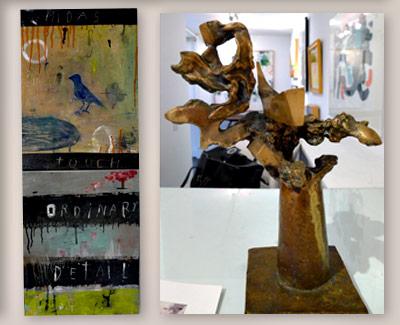‘Dealer’s Choice’ Gives New Perspectives

If it was anyone else, it might be considered a garage sale, a large collection of mostly unrelated objects put out on display perhaps because the owner is redecorating or raising money for another purpose.
At Kathryn Markel’s gallery space in Bridgehampton, however, that owner is Arlene Bujese, who has spent a lifetime collecting and selling the work of the South Fork artists she has represented and who are also friends. In this case, “Dealer’s Choice” is something more, not quite a full-fledged curated exhibition but a very impressive salon with pieces from her own collection supported by recent contributions by the same or different artists.
Ms. Bujese has been a loyal and persistent exhibitor of work from artists who were or are working on the South Fork, bringing many of them to the attention of new generations of viewers who might never have known of their contribution and their rank as peers of the best of the New York School artists.
John Little, who is hardly a household name, has steadily built a posthumous reputation mostly due to the efforts of Ms. Bujese to bring him to the attention of audiences in Washington, D.C., while he was alive, and at Spanierman’s East Hampton gallery, where she organized some of the gallery’s shows after she closed her own gallery in the same space. The Spaniermans were so taken with the artist that they have mounted solo shows in New York City of his work and several other artists who were brought to their attention by Ms. Bujese.
While there is no organizing principle to the 40 works on view, the individual pieces do share visual affinities with each other. In some cases, there are multiple works by an artist, such as Darlene Charneco, with her painted and nailed wood boards that look like artistic circuitry, and Fulvio Massi, whose paintings here resemble a chaotic Saul Steinberg. Others, such as Calvin Albert and Elaine de Kooning, are mixed in with disparate artists. It allows the viewer a chance to compare and contrast various styles.
Some of the strongest works are from the Abstract Expressionist period or inspired by it. Mary Abbott’s gouache painting looks similar to a Jackson Pollock painting from the same era but seems fresher and livelier than some of his lesser works we have come to know in the same style. Sharing an affinity for Hans Hofmann and Willem de Kooning, Little’s works are real standouts and have a vibrancy that makes them look like they were painted yesterday. The Elaine de Kooning paintings have interest and a delicate balance, but are more brooding. James Brooks is another example of a more known painter who still never reached the heights of success of some of his neighbors. His 1970 lithograph “Charbon” is indicative of his style and has an organic, almost Asian feeling about it.
Although collected by major institutions and a longtime instructor at Pratt, Albert, a sculptor who died in 2007 and studied with Alexander Archipenko and Laszlo Moholy-Nagy, might be unfamiliar to most people. Ms. Bujese is showing two strong sculptural works and a knockout Cubist-style drawing that loses nothing to the anachronistic era — 1955 — it was executed in. He lived in East Hampton from the mid-1960s to the mid-1980s.
Two of Carol Hunt’s recent paintings are presented side by side. They are abstract and full of movement, some portions poured in a thin stain and others thick and viscous. Separated by a few years, the works share a similar palette even as they express quite different compositions.
There are two sculptures by Arline Wingate on view that Ms. Bujese has put up for sale to benefit East End Hospice at the full purchase price. The cast bronze sculptures are from the mid-1960s and are built up with geometric shapes that suggest organic forms along with the titles “Thorn Flower” and “Night Flower.” Ms. Bujese said the donation would have been in keeping with Ms. Wingate’s wishes. The artist died in 1998 and was a good friend of hers.
With such a wide array of styles and time periods, it is a show that begs multiple viewings. Even just changing viewpoints from the front to the back of the gallery and back again gives new perspectives. The exhibition can be seen through Feb. 2.
